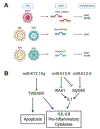Viral non-coding RNAs: Stealth strategies in the tug-of-war between humans and herpesviruses
- PMID: 32631785
- PMCID: PMC7779692
- DOI: 10.1016/j.semcdb.2020.06.015
Viral non-coding RNAs: Stealth strategies in the tug-of-war between humans and herpesviruses
Abstract
Oncogenic DNA viruses establish lifelong infections in humans, and they cause cancers, often in immunocompromised patients, despite anti-viral immune surveillance targeted against viral antigens. High-throughput sequencing techniques allowed the field to identify novel viral non-coding RNAs (ncRNAs). ncRNAs are ideal factors for DNA viruses to exploit; they are non-immunogenic to T cells, thus viral ncRNAs can manipulate host cells without evoking adaptive immune responses. Viral ncRNAs may still trigger the host innate immune response, but many viruses encode decoys/inhibitors to counter-act and evade recognition. In addition, ncRNAs can be secreted to the extracellular space and influence adjacent cells to create a pro-viral microenvironment. In this review, we present recent progress in understanding interactions between oncoviruses and ncRNAs including small and long ncRNAs, microRNAs, and recently identified viral circular RNAs. In addition, potential clinical applications for ncRNA will be discussed. Extracellular ncRNAs are suggested to be diagnostic and prognostic biomarkers and, with the realization of the importance of viral ncRNAs in tumorigenesis, approaches to target critical viral ncRNAs are emerging. Further understanding of viral utilization of ncRNAs will advance anti-viral therapeutics beyond conventional medication and vaccination.
Keywords: Circular RNA; Herpesvirus; Immune evasion; Non-coding RNA; Tumorigenesis; microRNA.
Copyright © 2020. Published by Elsevier Ltd.
Figures



Similar articles
-
Non-Coding RNAs and Immune Evasion in Human Gamma-Herpesviruses.Viruses. 2025 Jul 17;17(7):1006. doi: 10.3390/v17071006. Viruses. 2025. PMID: 40733622 Free PMC article. Review.
-
Long non-coding RNAs in antiviral immunity.Semin Cell Dev Biol. 2021 Mar;111:126-134. doi: 10.1016/j.semcdb.2020.06.009. Epub 2020 Jun 21. Semin Cell Dev Biol. 2021. PMID: 32580911 Review.
-
Viral Noncoding RNAs in Cancer Biology.Adv Exp Med Biol. 2016;927:367-89. doi: 10.1007/978-981-10-1498-7_14. Adv Exp Med Biol. 2016. PMID: 27376743 Review.
-
Idiosyncrasies of Viral Noncoding RNAs Provide Insights into Host Cell Biology.Annu Rev Virol. 2019 Sep 29;6(1):297-317. doi: 10.1146/annurev-virology-092818-015811. Epub 2019 Apr 30. Annu Rev Virol. 2019. PMID: 31039329 Free PMC article. Review.
-
The Diverse Roles of microRNAs at the Host⁻Virus Interface.Viruses. 2018 Aug 19;10(8):440. doi: 10.3390/v10080440. Viruses. 2018. PMID: 30126238 Free PMC article. Review.
Cited by
-
Enhanced hierarchical attention networks for predictive interactome analysis of LncRNA and CircRNA in oral herpes virus.J Oral Biol Craniofac Res. 2025 May-Jun;15(3):445-453. doi: 10.1016/j.jobcr.2025.02.012. Epub 2025 Mar 10. J Oral Biol Craniofac Res. 2025. PMID: 40144645 Free PMC article.
-
Viral RNA Is a Hub for Critical Host-Virus Interactions.Subcell Biochem. 2023;106:365-385. doi: 10.1007/978-3-031-40086-5_13. Subcell Biochem. 2023. PMID: 38159234
-
MicroRNA-mediated regulation of lipid metabolism in virus-infected Emiliania huxleyi.ISME J. 2022 Nov;16(11):2457-2466. doi: 10.1038/s41396-022-01291-y. Epub 2022 Jul 22. ISME J. 2022. PMID: 35869388 Free PMC article.
-
The m6A landscape of polyadenylated nuclear (PAN) RNA and its related methylome in the context of KSHV replication.RNA. 2021 Sep;27(9):1102-1125. doi: 10.1261/rna.078777.121. Epub 2021 Jun 29. RNA. 2021. Retraction in: RNA. 2022 Feb;28(2):274. doi: 10.1261/rna.079042.121. PMID: 34187903 Free PMC article. Retracted.
-
Human Identical Sequences, hyaluronan, and hymecromone ─ the new mechanism and management of COVID-19.Mol Biomed. 2022 May 20;3(1):15. doi: 10.1186/s43556-022-00077-0. Mol Biomed. 2022. PMID: 35593963 Free PMC article. Review.
References
Publication types
MeSH terms
Substances
Grants and funding
LinkOut - more resources
Full Text Sources
Other Literature Sources
Medical

